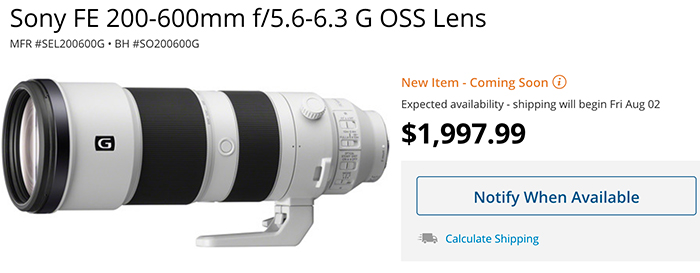
Press Release: Sony Announces New FE 200-600mm F5.6-6.3 G OSS Super-telephoto Zoom Lens | sonyalpharumors
USA Preorders: Sony 200-600mm FE at Amazon, BHphoto, FocusCamera, BuyDig and Adorama. Sony 600mm FE GM at Amazon, BHphoto, FocusCamera, BuyDig and Adorama. EU Preorders: Sony 200-600mm FE at Calumet DE. WexUK. ParkCameras. Calumet NL. Cameratools NL. Sony 600mm FE GM at Calumet DE. WexUK...
 www.sonyalpharumors.com
www.sonyalpharumors.com
- versatile tele-zoom range from 200mm telephoto to 600mm super-telephoto
- Compatible with Sony’s E-mount 1.4x and 2.0x teleconverters, extending the reach to a maximum of 840mm at F9 or 1200mm at F13 with outstanding image quality and AF performance
- Built-in optical stabilization with three different mode settings, enabling images that are sharp and in-focus at extended super-telephoto focal lengths
| Lens Specifications | |
|---|---|
| Name | Sony FE 200-600mm f/5.6-6.3 G OSS SEL200600G |
| Image Circle | 35mm (Full-frame E-Mount) |
| Type | Telephoto Zoom |
| Focal Length | 200 - 600mm |
| APS Equivalent | 300 - 900mm |
| Max Aperture | f/5.6 - 6.3 |
| Min Aperture | f/32 - 36 |
| Diaphragm Blades | 11 (rounded) |
| Lens Construction | 24 elements in 17 groups, including 5 ED (Extra-low Dispersion) glass elements and 1 aspherical element; Nano AR coating; Fluorine coating on the front element |
| Diagonal Angle of View(Based on image circle) | 12.5 to 4.2 degrees |
| Focus Details | AF via DDSSM (Direct Drive Super Sonicwave Motor); AF/MF switch; Focus limiter switch; 3 Customizable focus hold buttons |
| Front Element Rotation | No |
| Zoom System | Rotary (internal zoom) |
| Closest Focus | 2.4m / 7.87 ft. |
| Magnification Ratio | 0.66x / 1:1.52 |
| Filter Size | 95mm |
| Dimensions(Length x Diameter) | 318.0mm x 111.5mm / 12.52 in. x 4.39 in. |
| Weight | 2115g / 74.6 oz (without tripod mount) |
| Notes | Optical SteadyShot Image Stabilization; Dust and moisture resistant; Included Accessories: hood, front cap, rear cap, soft case, lens strap. |
| Typical Online Price | US$2,000 (Avail. August 2019) |
I´m still in hope that Canon will build such a lens too... for RF mount
